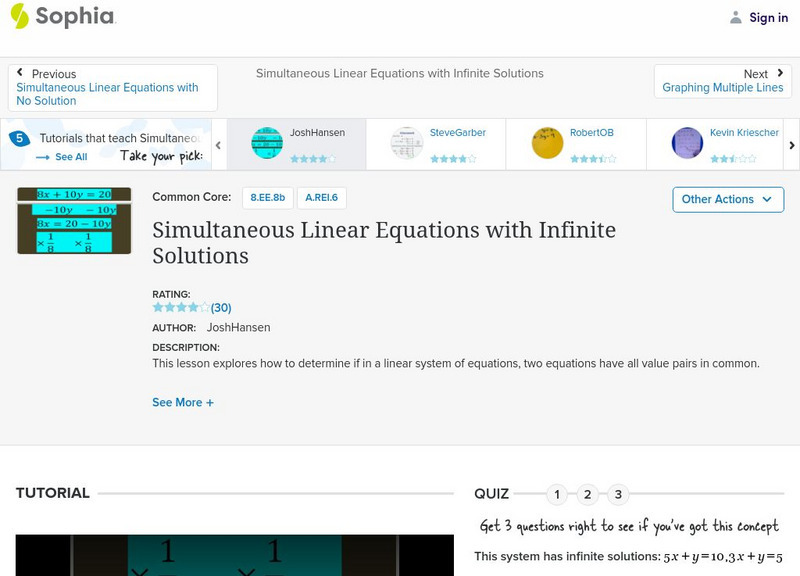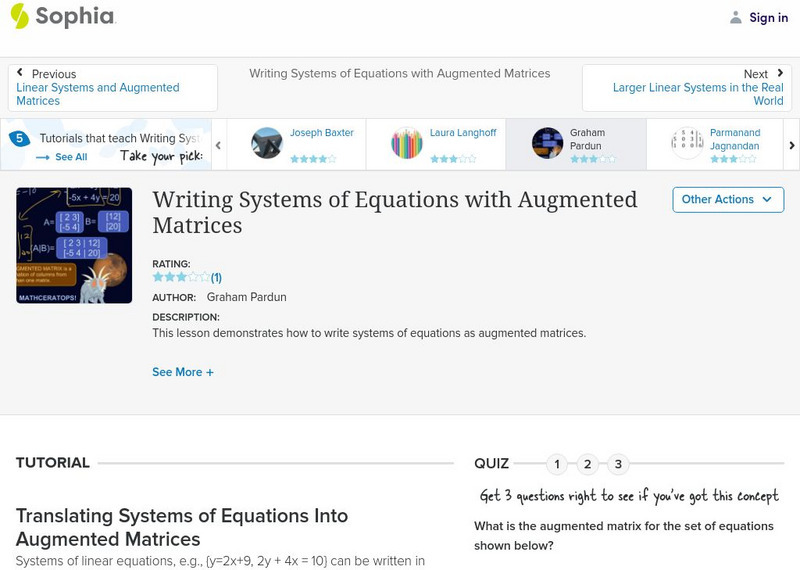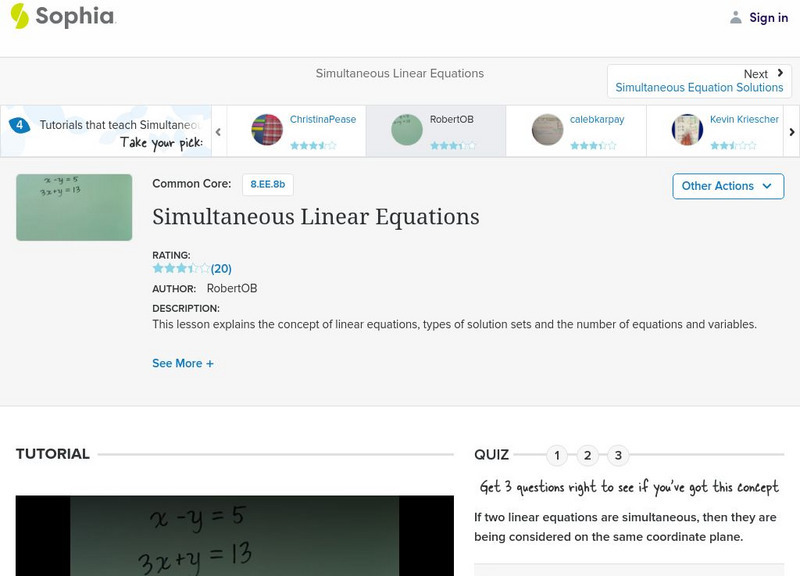Khan Academy
Khan Academy: Linear Algebra: Reduced Row Echelon Form 3
Video shows another example of using matrices and reduced row echelon form to simplify a system of 3 equations in 4 variables. Explains how to determine how many solutions the system will have by looking at the reduced row echelon form....
Khan Academy
Khan Academy: Linear Algebra: Reduced Row Echelon Form 1
Video shows how to use matrices and reduced row echelon form to simplify a system of 3 equations in 4 variables. Shows how the system relates to vectors to help visualize what the solution represents. This video also appears in the...
Khan Academy
Khan Academy: Linear Algebra: Reduced Row Echelon Form 2
Video shows example of using matrices and reduced row echelon form to solve a system of 3 equations in 3 variables. This video also appears in the strand Algebra: Matrices. [7:37]
Khan Academy
Khan Academy: Linear Algebra: Reduced Row Echelon Form 2
Video shows example of using matrices and reduced row echelon form to solve a system of 3 equations in 3 variables. This video also appears in the strand Algebra: Matrices. [7:37]
Khan Academy
Khan Academy: Linear Algebra: Matrices to Solve a Vector Combination Problem
Demonstrates how to find the appropriate combination of two given vectors in order to obtain a third given vector. This is done by representing the problem with a single matrix equation and solving that equation. [14:20]
Sophia Learning
Sophia: Simultaneous Linear Equations With Infinite Solutions: Lesson 11
This lesson explores how to determine if in a linear system of equations, two equations have all value pairs in common. It is 11 of 11 in the series titled "Simultaneous Linear Equations with Infinite Solutions."
Sophia Learning
Sophia: Simultaneous Linear Equations With Infinite Solutions: Lesson 8
This lesson explores how to determine if in a linear system of equations, two equations have all value pairs in common. It is 8 of 11 in the series titled "Simultaneous Linear Equations with Infinite Solutions."
Sophia Learning
Sophia: Simultaneous Linear Equations With No Solution: Lesson 6
This lesson explores how to determine if a linear system of equations has no value pairs in common. It is 6 of 10 in the series titled "Simultaneous Linear Equations with No Solution."
Sophia Learning
Sophia: Solving a System of Linear Equations by Graphing: Lesson 1
This lesson will review how to solve for a linear system of equations by graphing. It is 1 of 14 in the series titled "Solving a System of Linear Equations by Graphing."
Sophia Learning
Sophia: Simultaneous Linear Equations: Lesson 6
This lesson explains the concept of linear equations, types of solution sets and the number of equations and variables. It is 6 of 7 in the series titled "Simultaneous Linear Equations."
Sophia Learning
Sophia: Writing Systems of Equations With Augmented Matrices
This lesson demonstrates how to write systems of equations as augmented matrices. Students can watch a tutorial video and then take a quiz.
Virtual Nerd
Virtual Nerd: What's a System of Linear Equations?
A system of linear equations is a set of linear equations with the same variables. To solve a system of equations, you need to figure out the variable values that solve all the equations involved. This tutorial will introduce you to...
Khan Academy
Khan Academy: Matrices: Reduced Row Echelon Form 2
This video shows an example of solving a system of linear equations by putting an augmented matrix into reduced row echelon form.
Sophia Learning
Sophia: Using Elementary Row Operations to Solve for Systems of Equations
This video lesson demonstrates how to solve a system of linear equations by using matrix row operations. Students can check their understanding with an assessment.
Khan Academy
Khan Academy: Solving Systems by Elimination: Reduced Row Echelon Form 1
Video shows how to use matrices and reduced row echelon form to simplify a system of 3 equations in 4 variables.
Khan Academy
Khan Academy: Solving a System of 3 Equations and 4 Variables Using Matrix
Sal solves a linear system with 3 equations and 4 variables by representing it with an augmented matrix and bringing the matrix to reduced row-echelon form.
Khan Academy
Khan Academy: Solving Systems of Linear Equations Harder Example
Watch [4:29] Sal work through a harder Solving systems of linear equations problem.
Sophia Learning
Sophia: Simultaneous Linear Equations: Lesson 2
This lesson explains the concept of linear equations, types of solution sets and the number of equations and variables. It is 2 of 7 in the series titled "Simultaneous Linear Equations."
Sophia Learning
Sophia: Simultaneous Linear Equations: Lesson 3
This lesson explains the concept of linear equations, types of solution sets and the number of equations and variables. It is 3 of 7 in the series titled "Simultaneous Linear Equations."
Sophia Learning
Sophia: Simultaneous Linear Equations: Lesson 1
This lesson explains the concept of linear equations, types of solution sets and the number of equations and variables. It is 1 of 7 in the series titled "Simultaneous Linear Equations."
Sophia Learning
Sophia: Simultaneous Linear Equations With Infinite Solutions: Lesson 2
This lesson explores how to determine if in a linear system of equations, two equations have all value pairs in common. It is 2 of 11 in the series titled "Simultaneous Linear Equations with Infinite Solutions."
Sophia Learning
Sophia: Simultaneous Linear Equations With Infinite Solutions: Lesson 7
This lesson explores how to determine if in a linear system of equations, two equations have all value pairs in common. It is 7 of 11 in the series titled "Simultaneous Linear Equations with Infinite Solutions."
Sophia Learning
Sophia: Simultaneous Linear Equations With No Solution: Lesson 5
This lesson explores how to determine if a linear system of equations has no value pairs in common. It is 5 of 10 in the series titled "Simultaneous Linear Equations with No Solution."
Sophia Learning
Sophia: Using Determinants to Classify 2x2 Matrices
This lesson demonstrates how the determinant of a 2x2 matrix can be used to tell whether or not the matrix represents a dependent linear system, an inconsistent linear system, or neither.























